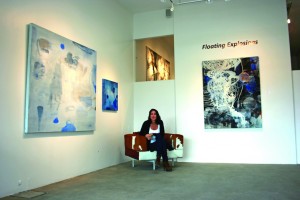Slender, dark-haired Lisa Aslanian speaks softly but with conviction as she shows visitors around her sparsely furnished 1,000-square-foot space, The George Gallery. The venue derives its name from George Sand, a pseudonym for the intrepid 19th-century writer Aurora Dupin.
On North Coast Highway in Laguna Beach (a city halfway between Los Angeles and San Diego), where ocean breezes waft in the door and commercial art is prevalent in nearby galleries, Aslanian exhibits women artists only—each with a provocative perspective. In this intimate gallery, providing a framework for these artworks, she explains, “The way we experience art is influenced by where it is housed, and that housing is like a place of worship.” In this “housing,” she challenges her viewers’ visual literacy with lyrical, figurative, sculptural and abstract art that examines feminist and gender issues, with some works presenting aggressive sexuality and/or parodies of domesticity.
The former art professor at The New School for Social Research in New York opened The George Gallery in January 2012. When asked about her artists, she points to the images on the walls and eagerly pulls pieces out of storage. “Her canvases are so alive, layered, complex, and full of life, colors and shapes,” she says of a Mary Jones’ abstract painting. She also represents Jill Levine’s pre-Columbian sculptural dolls which allude to a pan-cultural symbolism; Theresa Hackett’s abstract paintings, combining ordered chaos with female shapes; photos by Carla Gannis, whose contemporary “Jezebels” are saturated with intense reds reminiscent of mid-century “noir” films; and Sandra Bermudez, who shoots close-ups of deeply colored lips with pop aspects.
Aslanian seemed destined to open a gallery dedicated to gender issues, as these concerns have haunted her since childhood. Interviewed on a warm autumn afternoon, she is forthcoming, thoughtful, intelligent, telling me how she created her gallery based on her personal passions and scholarly engagement.
As a suburban New Jersey teen, she discovered the French writer Albert Camus, remarking, “His claim that the only reason to live is that there is nothing quite like this day, this moment, was one of the most beautiful ideas I ever read.” She also spent time frequenting art museums in Manhattan. Later, in college, she pursued her passion for art, culture, philosophy and French literature.
After extensive travel, followed by completion of an art history doctorate at The New School, she began teaching in downtown Manhattan, within walking distance of galleries and museums where she and her students were able to experience that vibrant art world directly.
Aslanian later married and had twins, while continuing to teach. But her life changed dramatically when she and her family moved to Orange County in 2008. “I expected to teach here but there were no jobs.” Relegated to staying home, she taught herself Spanish and spent hours reflecting on her life. “As a stay-at-home mom, I had a personal conflict between ambition and nurturing.” While caring for her children, her ambitious side compelled her to re-examine her lifelong interest in contemporary art.
Soon after, while going through a divorce, she sought sanctuary as a gallery assistant at Salt Fine Art in Laguna Beach. “The art there is loaded with sociopolitical commentary and observations about violence, sexuality and submission. While working there, I finally determined to open my own gallery.”
Among the dozens of female artists who inspire her—whose work she finds penetrating and revelatory—are Marina Abramovic, Marlene Dumas, Frida Kahlo and Dorothea Tanning. She explains that these women’s liminal art may bring us to the edge or open us to another plane of existence, adding that their confrontation of gender issues can threaten us on a fundamental level.
While feminist art has been around for decades, few galleries address these issues exclusively. The George Gallery is in fact an anomaly in conservative Orange County. “While interested people have come here out of the woodwork, I am not sure there are enough local buyers to sustain us,” she says. Yet the gallery’s innovative perspective, exemplified by its recent “Pop Noir” exhibition that explored the intersection of popular culture with desire and perversion, created a buzz way beyond OC’s borders.
Aslanian plans to keep her current venue while also expanding to Los Angeles, where the art, she says, “will be gutsier and more conceptual, with fewer traditional media.” And perhaps where it will live up to the fearlessness of its namesake, George Sand.
Info@Thegeorgegallery.com




















0 Comments